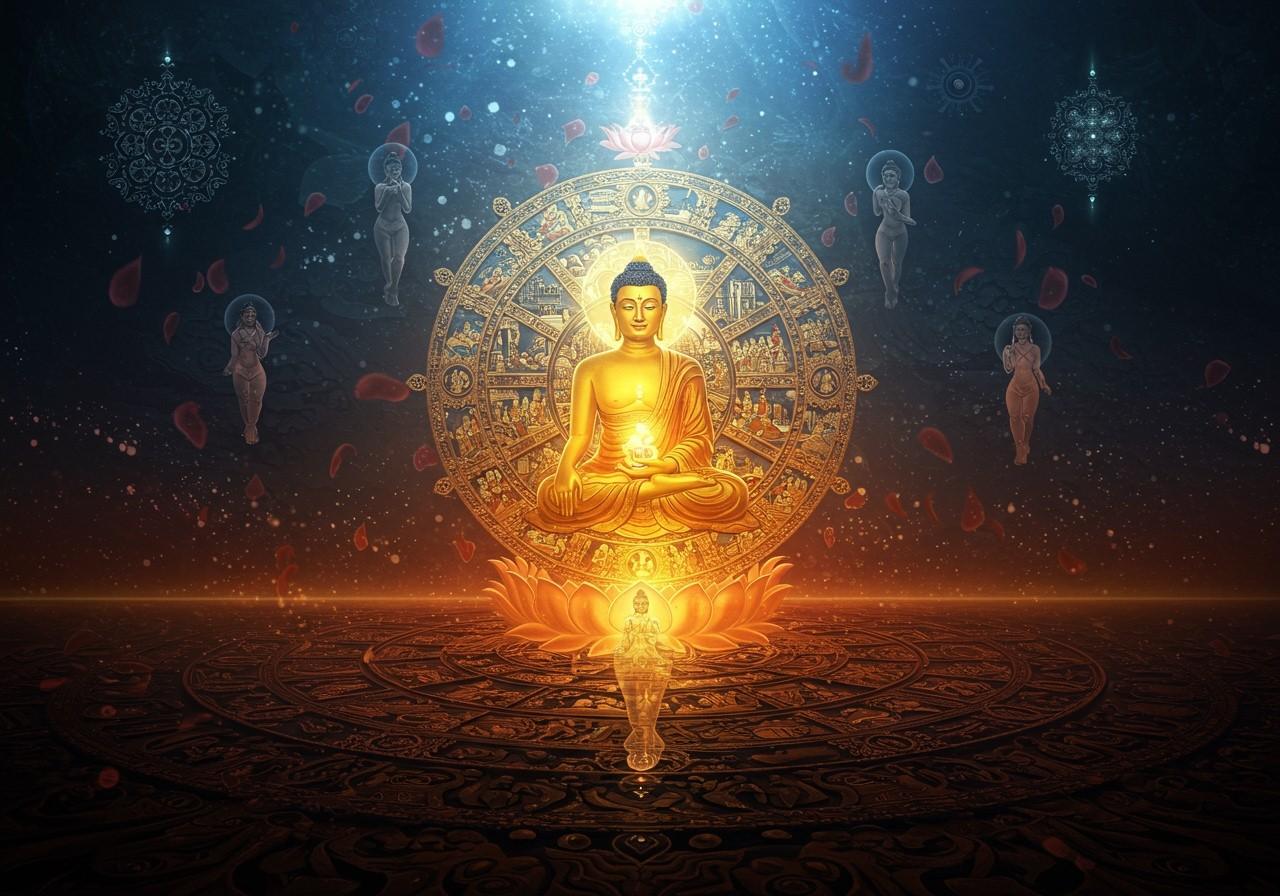
Buddhism, a major world religion originating in ancient India over 2,500 years ago, offers profound insights into existence and the path to spiritual liberation. Samsara and Nirvana are key concepts central to understanding the cycle of life, death, and rebirth, and the ultimate goal of spiritual practice.
What is Samsara?
Samsara, derived from Sanskrit, meaning ‘wandering’ or ‘world’, refers to the continuous cycle of birth, death, and rebirth. This cycle, marked by dukkha (suffering), stems from ignorance and attachment. Karma, the law of cause and effect, drives Samsara, where actions in one life shape future lives.
Buddhism describes Six Realms of Samsara:
- Gods
- Demi-gods
- Humans
- Animals
- Hungry Ghosts
- Hell Beings
Beings cycle through these realms based on their karma. The concept of Anatta (non-self) emphasizes the absence of a permanent self within Samsara.
The Four Noble Truths are crucial for understanding Samsara:
- The truth of suffering
- The origin of suffering
- The cessation of suffering
- The path to the cessation of suffering
Meditation, mindfulness, ethical conduct, and wisdom are vital for transcending Samsara. Texts like the Pali Canon elaborate on this concept.
What is Nirvana?
Nirvana, from Sanskrit, meaning ‘to blow out’ or ‘extinguish’, is the ultimate goal in Buddhism—the end of suffering and liberation from Samsara. It’s a state of perfect peace, free from desire, ignorance, and attachment.
In Theravada Buddhism, Nirvana (or Nibbana) is the unconditioned state. Bodhi (awakening) is crucial for attaining Nirvana. The Eightfold Path, including Right Understanding, Right Intention, and Right Mindfulness, is essential for achieving Nirvana.
Nirvana differs from Parinirvana, the final Nirvana at death. Mahayana Buddhism incorporates Sunyata (emptiness) and the Bodhisattva path into the concept of Nirvana. Texts like the Dhammapada offer teachings on Nirvana.
Samsara vs. Nirvana: Key Differences and Connections
Samsara, often perceived as a superficial reality, involves struggles and pain due to attachment and ignorance. Nirvana represents a deeper understanding and ultimate peace, liberation from Samsara’s cycle.
Understanding Samsara is crucial for realizing Nirvana. Karma plays a key role, as our actions influence our journey toward liberation. Ethical conduct, meditation, and wisdom are essential for transitioning from Samsara to Nirvana. The Buddha’s “Middle Way” advocates a balanced approach, avoiding extremes.
Realizing Anicca (impermanence) and Anatta (non-self) aids in breaking free from Samsara. The Buddha’s teachings, like the parable of the raft, illustrate this journey.
Samsara and Nirvana in Daily Life
Integrating these concepts into daily life is practical and beneficial. Mindfulness cultivates awareness of Samsara’s nature. Ethical living aligns with Buddhist principles. Community support nurtures spiritual growth. Rituals and traditions reinforce these concepts. Continuous learning and reflection on teachings are vital.
Modern Buddhists apply these principles personally and professionally, making conscious choices reflecting their spiritual path.
How Poojn.in Supports Your Buddhist Spiritual Journey
Poojn.in offers a wide selection of items to support your Buddhist practices and understanding of concepts like Nirvana and Samsara:
- Meditation Supplies: Enhance your meditation practice with our high-quality incense sticks, cushions, mats, and bells. Create a serene environment conducive to deepening your understanding of Nirvana and breaking free from Samsara. Explore our range of meditation accessories to support your spiritual journey.
- Buddhist Ritual Items: Deepen your connection to Buddhist traditions with authentic mala beads, incense, and butter lamps. These items can enhance your daily practices and create a sacred space for meditation and reflection.
- Sacred Texts and Study Materials: Expand your knowledge of Buddhist philosophy with our collection of sacred texts and study materials, providing clear explanations of concepts like Nirvana and Samsara. Delve deeper into the teachings and enhance your understanding of the path to enlightenment.
Conclusion
Understanding Samsara and striving for Nirvana offers profound wisdom and compassion. These concepts, rooted in tradition, remain relevant for spiritual growth. Mindfulness, ethical conduct, and continuous learning guide us towards liberation. Embrace these principles for a meaningful spiritual journey.
Explore more about Buddhist practices and philosophy:
- Common Meditation Challenges: How to Overcome Them
- Mindfulness Meditation: This is How You Cultivate Present Moment Awareness
- What is Japa? The Power of Repeating Sacred Names


